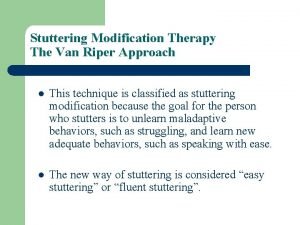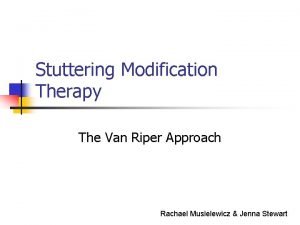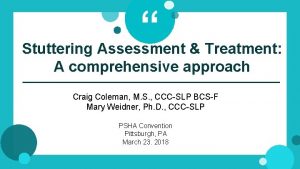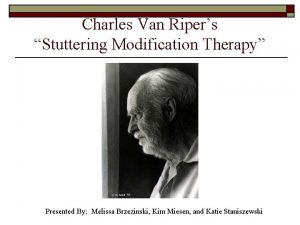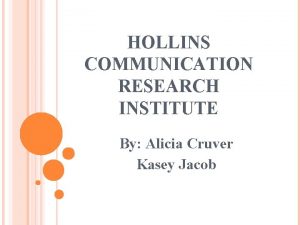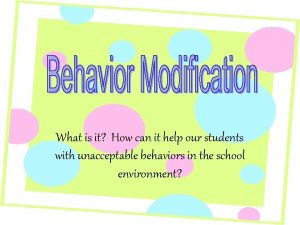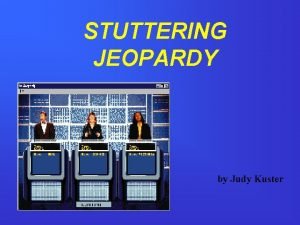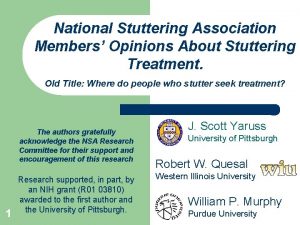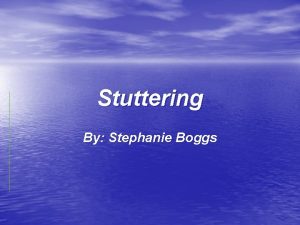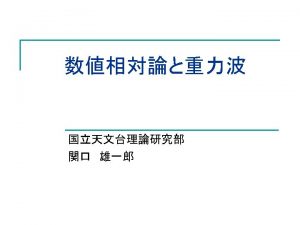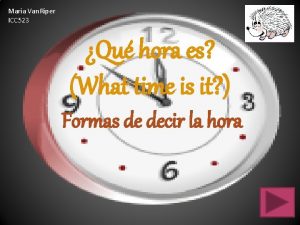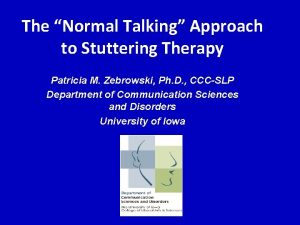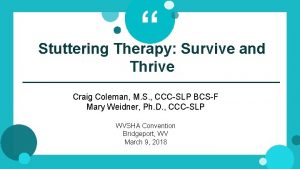Stuttering Modification Therapy The Van Riper Approach l












- Slides: 12

Stuttering Modification Therapy The Van Riper Approach l This technique is classified as stuttering modification because the goal for the person who stutters is to unlearn maladaptive behaviors, such as struggling, and learn new adequate behaviors, such as speaking with ease. l The new way of stuttering is considered “easy stuttering” or “fluent stuttering”.

Style of Presentation l Fairly intensive program l One hour of individual therapy and one hour of group therapy three days a week over a period of three to four months l Then, one or two times a week for another three to four months for stabilization

Four Phase Program l Identification l Desensitization l Modification l Stabilization

Identification Phase l Person who stutters recognizes and examines the core behaviors, secondary behaviors, and feelings and attitudes associated with his/her individual nature of stuttering. l Therapy strategies used to identify behaviors are oral reading, discussion, modeling stuttered behaviors, and self observation.

Desensitization Phase l Person who stutters learns strategies to reduce negative feelings and anxiety associated with stuttering. l Therapy strategies are to confront the disorder and desensitize the individual to stutter behaviors and listener reactions.

Modification Phase l Client learns how to use Van Riper’s modification techniques: Cancellations- after stuttering, there is a pause and the word is said a second time using an “easy” stutter. Pull-outs- when a person begins to stutter, they are to say the rest of the word with ease. Preparatory set techniques- when the person anticipates a word to be difficult, they are encouraged to work through all sounds of the word slowly and calmly.

Stabilization Phase l The person who stutters becomes self-aware and confident in monitoring his/her own stutter behaviors. l Clinician provides support for the client as independence is developed and therapy is gradually reduced. l Generalization and maintenance are addressed during the stabilization phase.

Maintenance l l The strategies learned during therapy are maintained by the client during the stabilization phase and after dismissal. When the client feels reoccurring stutter behaviors are a problem, it is encouraged to reiterate the phases of therapy with a pseudostutter. Generalization l The client is able to use the techniques learned in therapy in more natural contexts. l The client is encouraged to face situations that were feared and avoided prior therapy. l The client is dismissed from therapy once he/she becomes more confident and feels that stuttering moments in every day situations are manageable.

Success l Therapy is considered successful when the client changes from a person who stutters to a person who is in control and speaks fluently with occasional moments of mild stuttering.

Strengths Weaknesses l Program is individualized and feelings and attitudes associated with stuttering are considered. l Program requires excessive amount of time and effort to ensure strategy effectiveness. l Family and individual counseling are included in therapy. l There is a lack of evidence to support the approach. l The client develops a sense of internal locus of control. l Only appropriate for advanced stutterers. l Client becomes aware that disfluencies are common among all speakers.

Recommendations l Although there is not much evidence to support the Van Riper approach, it is recommended for use with an advanced stutterer. l It is an approach that has maintained efficacy throughout the years. l Clinical expertise provides rationale for use. l Prevention strategies are recommended for the beginning stutterer.

References Guitar, B. (1998). Stuttering: An integrated approach to its nature and treatment. Baltimore, MD. Williams & Wilkins. Jorgenson, M. (2001). Therapy and its importance. Retrieved on December 12, 2005 from http: //www. d. umn. edu/~cspiller/stutteringpage/therapy. htm Van Riper, C. (1973). The treatment of stuttering. Englewood Cliffs, NJ: Prentice-Hall
 Van riper stuttering modification therapy
Van riper stuttering modification therapy Van riper stuttering
Van riper stuttering Stuttering modification
Stuttering modification Van riper 1973
Van riper 1973 Precision fluency shaping program
Precision fluency shaping program Fluency shaping tekniği
Fluency shaping tekniği Paul van riper
Paul van riper Behavior modification therapy
Behavior modification therapy Psychoanalytic vs humanistic
Psychoanalytic vs humanistic Bioness integrated therapy system occupational therapy
Bioness integrated therapy system occupational therapy What are the major humanistic therapies
What are the major humanistic therapies Peo ot
Peo ot Stuttering jeopardy game
Stuttering jeopardy game
